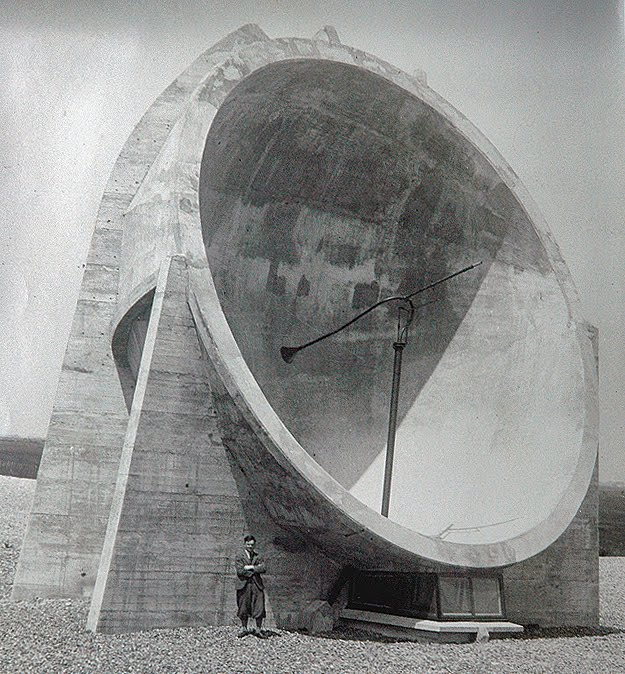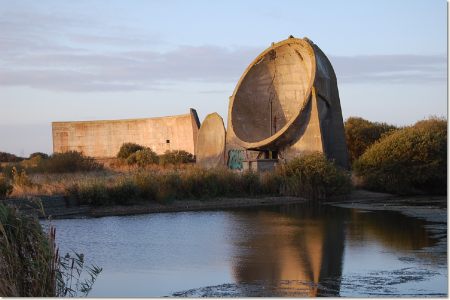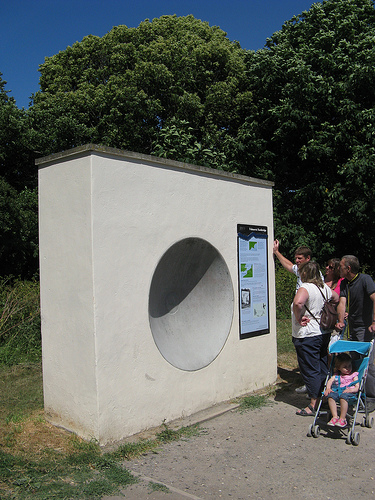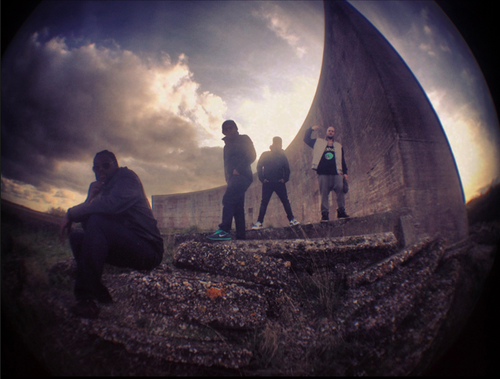
England’s Concrete Hearing Aids
Long, long before the real BMEWS “ultima-Thule” kept us safe, a conceptually similar but completely mechanical system guarded London during WWI and into the mid 1930s. AEWS; the Acoustic Early Warning System. And while there are little bits and pieces of it still dotting the English countryside, the most impressive part still exists in Denge, Kent, just behind the beach at Dungenes, a stone’s throw east of Romney Marsh, on that little point of land a few miles south of Dover where the Channel seems to hit its narrowest point.


85 years later: the “three sisters”: the 200’ wall, the 20’ dish, and the 30’ dish
[decimal map ref 50.956246, 0.953723] Once known as the quietest place in Britain, today the land around this proud nose of the old island is anything but. An airport right next door, row after row of vacation cottages just the other side, and all the busy traffic running up and down the coast, coming and going from the nearby Chunnel ... not to mention all the ships in the Channel, right there, or all the planes flying in or out of Heathrow shuttling back and forth to the Continent. Or that pesky miniature rail road! And even if they were all gone, you’d still have the bleating of the sheep, all those Romney lambs, up and down the meadows. Ah, but Once Upon A Time ...
London had been bombed repeatedly during the Great War. The Germans would send over giant Zeppelins at night, or enormous Gotha bomber planes by day, and bomb the city with relative impunity. Although neither of these aircraft were very fast, you simply could not hear them coming until they were only 6 or 7 miles away. And that left hardly any time to get some fighter planes up to defend the city. Something had to be done.
Something was. A whole series of “hearing trumpet” listening devices were invented, and some of those inventions even slightly worked. But it took some insight, and the application of some actual science, to get it right. Sound could be reflected off of a hard surface, and it could be focused if bounced off a curved surface. And those results were quite impressive indeed.
A 1916 account of tests of a sound mirror considered the invention to be a success: “A man 100m distant, reading a newspaper in a low voice was heard perfectly. Airplanes were heard up to distances of 8 kilometers.” Precursors to the concrete mirrors were cut directly into the chalk of the Kent hills, and there were experiments with acoustic mirrors at Hythe before the 1923 mirror; an earlier 20 foot cast concrete mirror had been built alongside a building lab, workshop, store and provisions for technical assistance to live on site. An acoustic research station was also built at nearby West Hythe.
Primitive sound locators were used on the Western Front to locate artillery and enemy aircraft as early as 1914, however it was events away from the Western Front that provided the real impetus for developing means of detecting and tracking aircraft by sound. In May 1915 Zeppelin and Shutte-Lanz airships of the German Army and Navy started bombing targets around the Humber and Thames estuaries. London was attacked for the first time on the 31st of that month and by 1917 the airships were being replaced by twin
engined Gotha and Giant aeroplanes. In total 300 tons of bombs were dropped on Britain during the First World War causing some 5,000 casualties, a third of which were fatalities. Some form of early warning system was badly needed, especially to counter the night raids.Following encouraging experiments with a four foot diameter prototype built by a Professor Mather a 16’ mirror was cut into a chalk cliff face at Binbury Manor between Sittingbourne and Maidstone in July 1915. The mirror was shaped to form part of a sphere and a sound collector was mounted on a pivot at the focal point. The collector was usually a trumpet shaped cone connected to the ears of the listener with rubber tubes but experiments with microphones were under way before the end of the war. The listener would move the sound collector across the face of the mirror until he found the point where the sound was loudest. Bearings to the target could then be read from vertical and horizontal scales on the collector.
Professor Mather and his colleagues carried out a series of experiments with this mirror and produced a report which claimed that it could detect a Zeppelin at a range of twenty miles.
From 1930 until 1935 the mirrors participated in the annual Air Defence of Great Britain exercises with the RAF. The 200’ mirror was the long range lookout, telling the operators of the 30’ and 20’ mirrors where to listen.
They in turn tracked the incoming aircraft and reported their readings back to a central control centre which calculated and plotted the raiders’ position. In 1932 the 200’ mirror detected aircraft at a range of 20 miles when the unaided ear could only hear them at 6.5 miles and on another occasion at 30 miles when an unaided listener could only hear them at 5.5 miles.
So, as a system, this worked very very much like the German radar of WWII. One set to give you a general bearing. Another set to make it precise. And a third set to guide a stealthy blacked out night fighter plane right onto the target.
The real problem was that airplanes developed at a much faster pace than did manual acoustic location technology. By the time the 3 mirrors at Denge were up and running, airplanes had become faster than they could track. And these were the best of the bunch - other, older, prototype models still dot the Kentish hills.
The real deathblow came when someone else realized that nearly the same job could be done electronically, and went out and invented radar. And that was that for AEWS.
By the beginning of the Second World War the mirrors became obsolete, and Rothwell went on to prominence for his work on missile guiding systems and radar. At the time, however, the mirrors were almost objects of ridicule, and referred to by his colleague physicists as “Rothwell’s Folly.” Recently Peter Kendall, the English Heritage Inspector of Ancient Monuments for Kent, has explained the reasons for the preservation of the mirrors. “Standing like huge modern sculptures in the otherwise featureless gravel, these structures are beautiful and fascinating, as well as historically important for the critical role they were designed to have in defending England.” Now that the mirrors are being hailed as objects of artistic merit, it seems cruelly ironic that the “sculptor,” once ridiculed for their construction, should not, until now, have received credit for their design.
I like how Mather’s / Tucker’s / Rothwell’s mirror shapes so closely resemble the radar antenna arrays of a generation or two later. A focusing curve is a focusing curve. Pity that the English gave these early inventors such a rough time for so long. It’s only in the past decade or so that they’ve woken up to the heritage they have here, and have made great strides to preserve it and to educate folks about it.
There is even a little sound mirror for public edification in a nearby park you and a friend can try for fun. Next time you visit the Military Canal be sure to give it a try. But please, BYOB (bring your own bombers). Actually, you stand in front of the mirror, and a friend stands 75 feet away on the other side of the canal, and whispers in your direction. And you can hear him just fine.

Neato, eh what?
The definitive work on this subject seems to be a very rare 2009 book called Echoes From The Sky by Richard N. Scarth. What a great title. Unfortunately the Hythe Civic Society printed so few copies of this book, the only book they’ve every published, that remaindered prices are quite silly.
minor update: Oops, I was wrong. Scarth used Hythe Civic Society to publish Mirrors By The Sea in 1995. A 40 page pamphlet. Another great title, and probably nearly the same content as the later book, except much less of it. I gather Scarth is the living expert. Alas, this book too is impossible to find at any rational price.
http://www.theromneymarsh.net/history/mirrors.htm
http://www.andrewgrantham.co.uk/soundmirrors/locations/romney-marsh/
http://www.andrewgrantham.co.uk/soundmirrors/ Mr. Grantham has done an excellent job and researched every sound mirror on the planet
http://theshriekingviolets.blogspot.co.uk/2012/09/sound-and-vision-hythes-acoustic-mirror.html
http://wikimapia.org/4598284/Denge-Early-Warning-Station
http://www.subterrain.org.uk/soundMirrors/ Scarth is pictured on this page
Other neat stuff in Kent that has little or nothing to do with this post, but indirectly lead me to finding these concrete wonders in the first place ...
http://www.theromneymarsh.net/history/canal.htm Once upon a time, the English dug a 29 mile canal to stop Napoleon when he invaded. He never invaded.
http://www.theromneymarsh.net/history/martello.htm But if he HAD invaded, he would have faced masses of these one gun mini-forts, up and down the coast.
http://www.telegraph.co.uk/earth/countryside/5015421/Romney-Marsh-lookers-a-thing-of-the-past.html Romney Marsh and the loss of the lookers
http://www.producedinkent.co.uk/wp-content/uploads/2014/01/SheepAhoyE-bro.pdf What the lookers were looking at: the Romney sheep breed and a bicycle tour of the area
http://www.c20society.org.uk/botm/rysted-house/ Rothwell’s house; he designed it himself. The home of one of the greatest acoustic researchers ever is inundated by the roar of the nearby highway. Sonic barriers were promised decades ago but never built. Gee, thanks.
Ok, for reading all the way to the end of this, you get a little bit of a prize. These days, Rothwell’s mirrors are popular with performers, and have been featured in several music videos. Nicki Minaj shot her Freedom video here; and while her director did not really have a clear understanding of what his backdrop was, or its history, he did notice that it had impressive sonic powers still.
